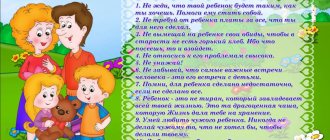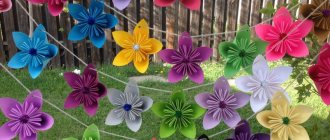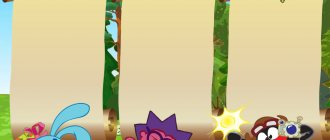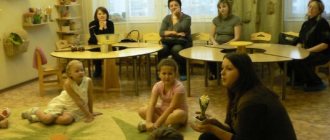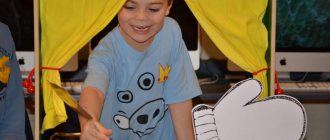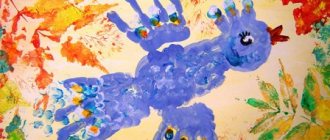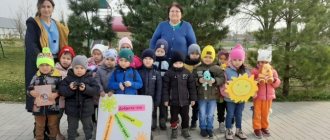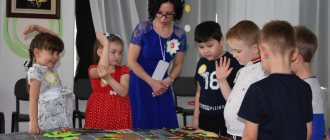In order to develop properly, five-year-old children need to arrange corners in kindergarten in the middle group. Their themes can be completely different, but, as a rule, they create special corners for health, duty or nature. In addition, special stands intended for parents will also carry a payload.
Health Corner
If it is necessary to focus on the physical education of children, then a health corner will play a huge role, in which children and their relatives can highlight useful information for themselves on how to properly maintain health, and all this can be created in a colorful and interesting form. To do this, it is necessary to take into account certain nuances.
sensory cornermethodological development on the topic
Sensory Corner
"Development"
To conduct classes on sensory development in the middle group, there are puzzles, board games (comparing objects by various properties: color, shape, size, material, properties); pyramids - single-color, multi-colored from 6-8, 12 rings, liner bowls, nesting dolls, game “Color the picture”; wooden toys, cubes, hammers; sounding toys: bells, pipes, squeakers, sounding balls; entertaining toys for the development of tactile sensations: flat animal figures with different surfaces - fur, velvet, silk, sandpaper.
The organization and arrangement of objects of the developmental environment in the sensory corner are carried out rationally, logically and conveniently for children. The arrangement of furniture, playground and other equipment meets the requirements of the Federal State Educational Standard, sanitary and hygienic requirements and safety regulations, the physiology of children, and the principles of functional comfort.
All games and objects in the sensory corner are designed to develop thinking and finger motor skills; development of visual perception and attention; for the purpose of teaching grouping objects by color, size, shape, etc. The main task of sensory didactic games is the accumulation of diverse sensory experience, which in classes in fine art activities and design will allow you to systematize accumulated knowledge, acquire new ones, and also use them in various situations and everyday life.
1. Arrange all games, toys and objects on tables according to lesson topics.
2. For clarity, you can stick geometric shapes of different sizes and numbers on the walls.
3. Change the set of games once every two months.
Construction Corner “Creative Kaleidoscope”
According to the Federal State Educational Standards, the group is equipped with spaces for play, construction, etc., as well as a variety of materials, games, toys and equipment that ensure free choice for children. The purpose of the design corner is to develop children’s creative potential, develop interest in artistic activities, develop aesthetic perception, imagination, artistic and creative abilities, independence, and activity.
In the corner there is the following construction material: a LEGO “Duplo” construction set with colored cards, visual models and diagrams, a wooden and plastic construction set, soft modules, plasticine. All material is classified by shape and size and stored in specially designated boxes. Large floor building materials are placed in the group's play area, as the free space on the floor makes it possible to build structures that children love to climb into and play with.
Building material is stored in the boxes in which it was purchased. All finished crafts are placed on a special rack in the shape of a ladder. You can also suggest playing with other furniture (tables and shelves) and harmoniously fitting it into the interior of the entire group.
To store boxes of construction materials, you can designate a part of the learning area where construction materials will be located. In order for the corner to have an aesthetic appearance and for ease of use, small images of the items they contain are pasted on the boxes.
You can put natural material in the boxes to make crafts, which children and parents collect themselves on walks. The inside of the box can be divided into cells, for example for storing acorns, seeds or threads, buttons.
The rule for creating a corner about health
Proper design of the corners of a middle group kindergarten is the most pressing issue. It should be in a place where children will always notice it, and accordingly the locker room would be the best option. Here, parents and children themselves will be able to find useful information. In order to make a title, you need to choose the brightest colors that will attract children. The font should be large, as it may be unpleasant for children to perceive small letters. The most important thing is the information that needs to be conveyed to the audience. All material should be as fresh and interestingly presented as possible, so that children do not get bored seeing it.
Important details for corners
In order to make corners in kindergarten in the middle group, you need to pay attention to some nuances. Here there must be simple recommendations that will indicate how to improve the health of children. These may be prescribed preventive measures or some other points that parents sometimes forget about. An obligatory component of such a corner should be information for the children themselves, that is, it is necessary to include some children’s sections or beautiful pictures. This is the only way to interest such a young viewer. Fairy-tale characters will do a great job promoting a good lifestyle, where children will emphasize the most new aspects of life for themselves. While washing or exercising, children will see and follow all the rules and recommendations.
The corner's children's pages should be as visible as possible. It is also better to diversify the stand with some drawings from the children themselves, which they will make on the topic of health.
Accordingly, you can build a parent’s corner in the middle group of a kindergarten, which will be useful for children too. If you put up a physical education stand, you can highlight all the information that will describe all the moments related to sporting events, relay races, competitions that will develop children. These could be sports results or photographs of children.
Subject-developmental environment in the middle group of kindergarten within the framework of the Federal State Educational Standard
Slide 1 Subject-based developmental environment in the middle group of a kindergarten within the framework of the Federal State Educational Standard. Completed by: Levshakova O.V, teacher of MBDOU “Kindergarten No. 18” “Crane” Specialist of the 1st qualification category
Slide 2 Subject development environment in preschool educational institutions. Particularly relevant today is the issue of organizing the subject-development environment of preschool educational institutions. This is due to the introduction of the Federal State Educational Standard (FSES) to the structure of the basic general education program of preschool education. In accordance with the Federal State Educational Standard, the program should be built taking into account the principle of integration of educational areas and in accordance with the age capabilities and characteristics of students. The solution of program educational tasks is provided not only in the joint activities of adults and children, but also in the independent activities of children, as well as during routine moments. Everyone knows that the main form of work with preschoolers and the leading activity of children is play. That is why we educators are experiencing an increased interest in updating the subject-development environment of preschool educational institutions.
Slide 3 What is a subject-specific developmental environment? (Terminology) The child’s development environment in the structure of the Federal State Educational Standard is a complex of material and technical, sanitary and hygienic, social, social, social, ergonomic, aesthetic, psychological, pedagogical, and spiritual conditions that ensure the organization of the lives of children and adults in preschool educational institutions.
Slide 4 Federal State Educational Standard requirements for a subject-development environment: 1. Accessibility for students of all premises of the organization where the educational process is carried out. 2. Free access for pupils to games, toys, materials, and aids that provide all basic activities.
Slide 5 Factors that should be taken into account when organizing PRS. Children should be protected in every possible way from the negative influence of toys that: provoke the child to aggressive actions and cause cruelty, provoke game plots associated with immorality and violence that are beyond the competence of childhood. Anthropometric factors ensuring compliance of height and age characteristics with the parameters of the subject development environment. Furniture must be in accordance with the requirements of SANPiN and Federal State Standards
Slide 6 The subject development environment should facilitate the implementation of educational areas in the educational process, including: 1) joint partnership activities of adults and children; 2) free independent activity of the children themselves in the conditions of a subject-based developmental educational environment created by teachers, which ensures that each child chooses activities according to his interests and allows him to interact with peers or act individually.
Slide 7 The subject-spatial development environment should be organized taking into account the requirements of the Federal State Educational Standard, where all five educational areas are clearly visible: 1) socio-communicative,
2) educational,
3) speech,
4) artistic and aesthetic,
5) physical.
Slide 8 Approximate centers for educational areas in light of the requirements of the Federal State Educational Standard Social and communicative development: Cognitive development: Speech development Artistic and aesthetic development Physical development: Traffic Safety Center
Fire Safety Center
Labor Center, Duty Corner
Game activity center (center for role-playing games)
Sensory Development Center
Center for Constructive Activity
Center for Mathematical Development
Experimentation Center Speech Development Center or Speech and Literacy Corner
Speech therapy corner Fine Arts Center or creativity corner
Center for Musical and Theatrical Activities Center for Physical Development - Sports Corner “Be Healthy!”
Slide 9 When creating a subject-development environment in our group, we set ourselves the goal of doing this with minimal economic costs, since we cannot count on serious material investments in equipping the subject environment. We tried to make the subject-development environment diverse, bright, and rich in information, in order to maximally speed up and facilitate the adaptation period of children in kindergarten, create an emotionally positive atmosphere in the group, and ensure the individual harmonious development of the child. We followed the zoning principle. Thanks to the organization of various play areas and corners using open shelving that does not clutter the room. The group has created conditions for different types of children's activities (play, productive and cognitive-research). In order for each child to be able to find something to do and do something they like and feel comfortable, centers for a specific type of activity are allocated in the group.
Slide 10 Direction: Artistic and aesthetic development. There is material and equipment for artistic and creative activities: drawing, modeling and appliqué. If desired, the child can find and use what is necessary to realize his creative ideas, plans, and fantasies. This center has free access.
Slide 11 Direction: Speech development plays a significant role in developing children’s interest and love for fiction. In this corner, the child has the opportunity to independently choose a book according to his taste and calmly examine it with bright illustrations.
Slide 12 Direction: Cognitive development. Center for Experimental Activities. It contains material for carrying out experimental activities: magnifying glasses, flasks, measuring cups, funnels, hourglasses, soil, stones, seeds, cereals, etc. Our little “whys” conduct simple experiments and determine the properties of various natural materials.
Slide 13, 14 includes environmental activities. This corner contains various types of indoor plants, which are convenient for demonstrating modifications of parts of the plant, tools for caring for these plants: sticks for loosening, a spray bottle, watering cans, etc. In addition to indoor plants, this center contains models (desert, animal world, aquarium , birdhouse, beehive, birdcage, etc.).
Slide 15 It’s winter outside, but in the group on the windowsill it’s spring. During the cold season, my children and I create a mini-vegetable garden on the windowsill. This is an opportunity for children to have live communication with plants. Anyone who starts such a vegetable garden will certainly become interested in experimentation and eco-design. I arranged the winter garden with great imagination: I designed it in the form of a village yard, decorated it with suitable buildings and decorative accessories.
Slide 16 The “construction” (constructive) center, although concentrated in one place and takes up little space, is quite mobile. Its practicality lies in the fact that with the contents of the construction corner (various types of construction sets, large and small construction sets), you can move to any place in the group and organize this activity.
Slide 17 (toy library) The center solves the following tasks: purposefully developing children’s interest in elementary mathematical activities, instilling in children the need to occupy their free time with not only interesting, but also games that require mental stress and intellectual effort.
Slide 18 Direction: Social and personal development. Play is the main activity of our children. A bright, rich play center creates conditions for children’s creative activity, develops imagination, develops gaming skills and abilities, and fosters friendly relationships between children. Attributes for role-playing games emerging at this age are freely available to children: “Family” “Hospital”
Slide 19 “Barbershop”
"Theater"
Slide 20 “Shop” “Garage”
Slide 21 «
Corner of nature
We should not forget that a corner of nature in the middle group of a kindergarten is also as useful as possible. All children love nature, making appliqués and looking at animals. It is not always interesting for a child to look at pictures in books, so such corners will be as useful as possible. They will not only decorate the group, but will also serve as a teaching tool. Little ones will enjoy taking care of flowers and interesting animals, which will develop a sense of responsibility and duty.
What plants and animals should I buy for the corner?
When creating corners in kindergarten in the middle group, you need to take care of the inhabitants of the living corner. Among the vegetation, you need to choose expressive plants that will have a bright appearance in order to keep the attention of the kids. They should also be unpretentious and as safe as possible. It is advisable to choose different types so that children understand that even plants have individuality. It is necessary to place plants so that they do not look intrusive, but so that, on the contrary, they create comfort in the group.
You also need to consider maximum lighting and humidity. For example, violets and begonias will not do well in direct sunlight, while cacti and geraniums like a lot of light. Also, don’t forget that children should have maximum access to plants so that they can easily care for them. As for preferred plants, it is better to choose prickly aloe, agave, asparagus or begonia. Children in the middle group will care for several types of indoor plants at once.
If we talk about pets, then the corners in kindergarten in the middle group should include turtles, lizards or ordinary fish in aquariums. You can get a furry rodent. As a rule, hamsters, mice and guinea pigs attract the attention of visitors more. They are very cute and unpretentious. In addition, these animals can be trained a little.
Project in the middle group “Duty Corner”
Middle group project
“Group duty corner”
Name of the organization implementing the project: Chernogorsk MBDOU "Teremok"
Completion time: project duration: 1 year
Project participants: teachers, middle school children, parents.
Relevance of the project:
Raising the younger generation in the spirit of respect and love for work is one of the main tasks of a preschool institution. Labor education, i.e., involving children in independent work within their capabilities and observing the work of adults, explaining its significance in people’s lives, plays an important role in the comprehensive development of the child’s personality. The main goal of labor education for children of middle preschool age is the formation of moral guidelines, hard work, and awareness of the usefulness of work. The work activity of a preschooler has a significant impact on the development of the child’s volitional traits, his thinking, speech, memory, attention, and imagination. From preschool age, every child must take part in work and perform simple duty duties.
Duty duty is one of the forms of organizing children’s work, which requires the child to perform work aimed at serving the team. Duty involves the work of one or more children in the interests of the entire group. Despite the seemingly insignificant result of labor, duty is of great importance in raising children. On duty, to a greater extent than on assignment, the social orientation of work, the real, practical care of several children for others, is highlighted, therefore this form contributes to the development of responsibility, a humane and caring attitude towards people and nature. Duty duties place the child under conditions of obligatory fulfillment of certain tasks necessary for the team. This allows children to develop responsibility towards the team, caring, and an understanding of the necessity of their work for everyone.
The goal of the project is to replenish the RPPS group with equipment and supplies for labor education. Formation of a positive attitude towards work in preschool children. Project objectives 1. Organize educational activities aimed at developing work skills and abilities, a sense of responsibility for one’s work activity. 2. Create a duty corner in the group, conditions for the implementation of labor education of children. 3. Create the necessary conditions for the manifestation of the labor activity of each child, awaken in children the desire to work, help adults, have a positive attitude towards the results of their work and the work of their peers. 4. Involve parents in the educational process. To interest parents in participating in the project, in providing assistance in organizing and replenishing the RPPS group, in preparing the necessary material for the “Duty Corner” 5. Participation of children and parents in events and exhibitions in preschool educational institutions
Required materials: • didactic games; • special methodological literature; • equipment for a duty corner; • material for the manufacture of aprons, scarves, caps and napkins; • material for designing the “Duty Corner” in the group. Educational areas of the project: social and communicative development, cognitive development, speech development
Estimated product of the project: 1. Creation of a “Duty Corner” in the group. 2. Making various kinds of didactic games 3. Card index of didactic games on labor education 4. Making aprons, scarves, caps, napkins for the duty corner, equipping with the necessary materials and equipment 5. Conducting conversations on labor education 6. Photo report on the work done 7. Systematized literary and illustrative material on the topic. 8. Developed consultations and booklets for parents on labor education and the development of independence in children.
Expected result Children get an idea of work and its types (self-service, household work, work in nature, get acquainted with the work of adults). Formed responsible attitude towards the assigned task. Carry out collective and individual assignments, understand the significance of the results of your work, take care of the timely completion of a joint task. Ability to independently perform duty duties. Be able to perform feasible work, help the teacher put in order the equipment used in work activities. To improve parental culture in matters of labor education of preschool children. Productive interaction between parents and children. Top up the group's RPP. References 1. Bondarenko, T. M. Introducing preschoolers to work. Methodological manual / T. M. Bondarenko. - Moscow: IL, 2014. - 208 p. 2. Bure, R. S. Preschooler and labor. Theory and methodology of labor education / R. S. Bure. - M.: Mozaika-Sintez, 2011. - 136 p. 3. Bure, Rosa Preschooler and labor / Rosa Bure. - M.: Mozaika-Sintez, 2014. - 2004 p. 4. Komarova, T. S. Labor education in kindergarten. Program and methodological recommendations / T. S. Komarova, L. V. Kutsakova, L. Yu. Pavlova. - Moscow: Higher School, 2009. - 719 p. 5. Labutina, N.V. Labor education of preschool children: a methodological guide for kindergarten teachers. / N.V. Labutina, A.A. Ivanova, N.P. Guseva. - Moscow: Gostekhizdat, 2016. - 2481 p. 6. Makhaneva, M. D. Teaching children to work / M. D. Makhaneva, O. V. Skvortsova. - M.: Sfera, 2012. - 2727 p. 7. Education of preschool children at work // Ed. V. G. Nechaeva. – M., 1999. 8. L. V. Kutsakova Labor education in kindergarten. -M., 2014.
9. Sergeeva D.V. Raising children in the process of labor activity. – M., 2000.
The result of the project. Long-term project implementation plan Stage Action, event Participants, responsible Result Dates Stage 1: preparatory 1. Setting goals, determining the relevance and significance of the project Educator Identification of the problem September 1 2. Selection of materials, study of methodological literature on this topic Educator Methodological support for the project From 1 to September 23 3. Long-term project planning. Development of a long-term work plan. Educator, parents Distribution of responsibilities for the successful implementation of the project From September 23 to 30 4. Discuss the goals and objectives of the project. Generate interest among parents in creating conditions for the implementation of the project. Educator, parents Distribution of responsibilities for the successful implementation of the project From September 23 to 30 5. Diagnosis of parents’ knowledge on the chosen topic Educator Analysis of results, solutions during the project duration 6. Organization of the RPPS creation of a “Duty Corner” Educator, parents Environment for the implementation of the project during project deadlines 7. Consultation with parents on labor education of children Educator. To help parents understand the importance of labor education for children during the duration of the project 8. Increasing the level of teacher self-education. Educator Replenishment of the subject-development environment with various kinds of didactic material and manuals during the duration of the project Stage 2 (basic, formative, practical) 1. Work with parents on involving the group in replenishing the “Duty Corner” group. Educator, parents Involve parents in replenishing the RPPS group during the project period 2. Production of schemes, algorithms, manuals Educator Parents Schemes, algorithms, manuals: • Algorithm for setting the table • Algorithm for washing toys • Algorithm for washing hands • Algorithm for making the bed • Algorithm for folding things correctly in the closet • Algorithm for dressing according to the seasons • Schemes of duty in the corner of the dining room, etc. during the project period 3. Preparation of consultations on labor education, carrying out work with parents on this topic Educator, parents Consultations: • “Joint work of children and parents” • “Duty as a form of organizing the work activities of preschoolers” • “Nurturing independence in preschool children” • “Labor education of children in the family” • “Effective advice for introducing children to work” • Recommendations for parents on labor education during the project period 4. Development notes "On duty" Educator Children Note 6. Making didactic games Educator Parents Various games:
• Find by silhouette • Arrange in order • Call affectionately • Table setting • Ability to use cutlery
• What did the artist mix up • Let’s make soup, compote • Supermarket • Pick up the shadow • What’s what and other games during the project’s duration
7. Posting information on labor education on the preschool educational institution website and on pedagogical portals Educator Material for sites during the project period 8. Educator, children Notes, photo report. 9. Development of a card index of games for labor education Educator Card index. 10. Making a calendar of duties in the group Teacher Duty calendar (dining room, classes) September-October. 11. Development of a duty schedule Educator Duty schedule in the group September 12. Development of conversations on labor education Educator Card file of conversations during the project period 13. Reading literature on labor education Educator, children. To form children’s ideas about work during the project period 3rd stage: control and diagnostic tic, final 1. Report at the teachers’ council on the work done Educator Photo collage (presentation) 2. Participation in the competition of the preschool educational institution “Duty Corner” Educator Presentation of experience and methodological developments at the preschool educational institution level 3. Publication of the project, consultations, manuals in Internet resources
In the middle group, cafeteria duty is usually introduced in the first half of the year. Complication comes due to an increase in the amount of work (full table setting). From the second half of the year, we begin to teach children to be on duty in preparing materials for classes.
The group, of course, needs a corner for those on duty. The duty officer's corner should have everything necessary for work: aprons, hats, scoops. Vases for napkins and bread bins are located in such a place that it is convenient for children to pick them up and put them away after use. This is what the duty officers' corner looks like in our group.
Application
DINING DUTY IN JUNIOR GROUPS
· Duties are of great importance in raising children:
. Those on duty always perform work that has social significance and is necessary for the team. Forms a desire to work for the sake of others, to show a caring attitude towards one’s comrades, to develop the ability to help an adult, to notice where help is needed.
· Being on duty in the canteen develops in children moral and volitional qualities and skills, the ability to accept a goal and achieve results.
· From the age of 2, children are involved in the preparation of the feeding process, carry out simple tasks: place chairs correctly at the table, place plates with bread in the middle of the tables, place spoons on the right side of the plates standing on the table.
· Dining room duty is carried out from the 2nd junior group.
· Tasks: help the assistant teacher set the table at which he and his friends are sitting. Distribute spoons, put out bread bins, vases with napkins.
· Before introducing duty, the teacher organizes special classes in which he shows and explains in detail all the actions, involving children in their implementation.
· While on duty, the teacher explains the need to work hard and encourages any attempt by the child to show independence.
· Reminds you of the order of priority in completing assigned tasks:
“Today Ira will take care of his comrades and will be on duty at his desk. Dima will set this table... Let them work for everyone today, and let other children do it tomorrow.”
· The teacher teaches children to carry out the assigned task without being distracted, without fussing, without rushing, without finishing one task, not to move on to another.
The teacher says in a friendly tone: “Kolya, don’t rush. Why are you in such a hurry? You will have time to do everything. Lay out the spoons carefully for all the children.”
Supervising the work of those on duty, the teacher reinforces the skills of laying out cutlery: “Spoons should be taken by the handle, one at a time, placed on the right side of the plate.” If forks are given, then the fork lies closer to the plate with its sharp ends up, and then the spoon with its convex side down. Now put the bread basket in the very middle of the table so that it’s easy for everyone to reach, and then put the napkins. First you need to finish one thing, and then start another.”
· “Let's see how you arranged the spoons. Did you miss anyone?
· The teacher supports indecisive children, encourages:
“I know, Nadyusha, you will set the table well now. Start handing out spoons: to Katya, and Sasha, and your friend Anya.”
· You should not constantly set the same children as an example and assign them to duty. Slightly higher demands can be placed on them.
· As children master skills, the teacher’s role in supervising those on duty changes. Initially, he reminds the kids of work techniques, the sequence of operations, and helps them cope with the task.
· Later, the adult limits himself to advice, general reminders, control, and approval.
· It is important that the duties of duty officers are performed by all pupils, and not just active and skillful ones.
DINING DUTY IN A MIDDLE GROUP
· Tasks:
-Form a responsible attitude for the assigned work.
-Cultivate concern for each other, a desire to help help. teacher, work carefully and diligently.
-Know how to properly set the table.
· The child on duty in the dining room must independently arrange forks, knives and spoons; put bread bins, vases with napkins; serve the second course; collect the dishes.
· The duty officer's corner should have everything necessary for work: aprons, caps, scoops, trays. Vases for napkins and bread bins are in such a place that it is convenient for children to pick them up and put them away after use.
· In the middle group, knives first appear in table settings, and the skill of handling them has not yet been developed.
· The volume of work in the middle group increases: children place saucers and cups from the serving table on children's tables, fill vases with napkins, lay out cutlery (spoons, forks, knives).
· In the middle group, each attendant serves one table.
Thus, duties are repeated frequently, and therefore children learn the necessary skills faster and better. The teacher needs to take into account the individual characteristics of children and the level of development of their work skills.
To work without haste, those on duty must be the first to finish the game and return to the room after a walk.
When the majority of the children are just starting to collect toys, the teacher reminds those on duty of their responsibilities and sends them to the group.
There they are met by the teacher's assistant (at this time she had already wiped the tables and placed a pile of dishes on each table).
The teacher and assistant teacher teach the attendants how to properly lay out the equipment.
The attendants place the plates, each opposite the high chair, spoons are placed to the right of them, and a glass with napkins is placed in the middle of the table. The cups are placed so that the handle is on the right side.
· If a knife is served for lunch, then it is placed to the right of the plate with the blade facing the plate, next to a spoon, then a salad fork.
The fork for the second one is on the left side of the plate.
A small spoon - in a saucer or next to a plate parallel to the edge of the table, the handle of the spoon should be on the right.
· The teacher must be patient and encourage those on duty:
“Seryozha was truly on duty today, he took care of everyone, he remembered everything himself, he didn’t forget anything.”
· The attendants remove bread bins and glasses with napkins from the table. They sweep the crumbs off the table, fold the tablecloths, turning to another person on duty for help.
· Do not overload the attendants with duties that each child must perform himself, for example, pushing in a chair, stacking plates, putting away a used napkin.
· At the end of the school year, children usually cope with cafeteria duty on their own, and the teacher is limited to control and individual reminders.
· It is important that the children on duty not only perform their duties, but also eat themselves without haste or interruption. Therefore, when the tables are set, soup is poured for those on duty before other children. Thus, those on duty are usually the first to finish lunch, after which they can begin their duties.
(The tablecloth on duty is folded in half on the table, and then in half again, and only then folded lengthwise).
DUTY FOR CLASSES
Lesson summary for middle group children
Goals:
Equipment: drawings for easels depicting equipment for art classes and elementary mathematics. Badges for flannelographs with images of pencils, brushes, jars, paints, rulers for counting, counting material... Sets of equipment for drawing, for modeling, for applique, for elementary mathematics.
Preliminary work. Carrying out individual assignments in preparation for classes. Supervising older children on duty.
PROGRESS OF THE CLASS
Educator. While the older children are preparing the desk for class, let's look out the window.
A short conversation is held about the weather (about the state of the sky, earth, trees). Outside the window, the children notice Carlson (the toy) and look through the glass. The teacher pulls Carlson by the fishing line through the window. Children say hello, ask any questions, comment on the situation.
Carlson. I want to be friends with you. Let's get acquainted!
Children say their names.
Educator. Carlson, we are about to have a lesson, so I ask you to sit on the windowsill. Places it in the study area next to the desks. After class you can play with the children. (Addresses the children) How many of you know the name of the children who prepare everything necessary for classes?
Children. On duty.
Educator. Yes, these are the duty officers. It turns out that you can be on duty not only in the canteen, but also in classes. Please look at what is shown in the pictures on the first easel.
Children. Paints, brushes, cups of water, napkins.
Educator. What activity do you think the attendants prepared these items for?
Children. For drawing.
Educator. Now think and tell me, what activity can be done with the objects drawn on the pictures of the second easel?
Children. Mathematics.
Educator. Why do you think so?
Children express their thoughts.
Educator. And who prepared all this?
Children. On duty.
Educator. Please tell me, for what lesson did the staff on duty prepare the material shown on the third beam?
Children. To the application.
Educator. Try to remember and name who puts the items needed for classes on the desks?
Children. On duty.
Educator. It turns out that the class attendants have a lot of work to do. You have already grown up and can also be on duty for classes. You need to be able to be on duty, know what items to prepare for what activity. Let's practice: I will name the item, and you will determine for what activity they will be needed. Lists: clay, pencils, glue, paints, metallophone, ball, scissors, hoop, abacus...
Children name the corresponding activities.
Educator. Employees on duty must be attentive while working. Why do you think?
Children express their thoughts and assumptions. With the help of the teacher, they come to the conclusion that proper duty helps all children study well.
Educator. I know that each of you has your favorite activity. Let's play with you. Imagine that you are all on duty. On flannelographs, each of you will attach those items that are needed for his favorite activity. And I'll try to guess what kind of activity this is. Just don't tell me. Agreed?
The teacher observes the children’s work and determines the activity. Unnoticed, he removes one item from each table and puts them near Carlson. As the children complete the task, they name the activities and justify their guesses. Children confirm or refute the teacher’s assumptions.
Educator. Now find a place at the table that is prepared specifically for your lesson. You can do your favorite thing there.
Children look for the right places and start studying. The teacher observes when everyone discovers a lack of equipment and how they react to it. If necessary, asks leading questions like: “why don’t you start gluing, cutting, painting...”, helps to find out the reason for the inability to complete the task. Together they conclude that those on duty must be very attentive and conscientious, otherwise the lesson will not work.
Carlson. Guys, it's my fault. I decided to make a joke and removed several items from your tables. Your duty officers are not to blame; they did everything right. And I let them down. Excuse me please. Take turns, name someone who needs something for work and I will return the missing item to you.
Children name the missing items and take them from Carlson. They work at tables of their own design.
Educator. Today I taught you how to be a good student on duty in preparation for classes. Tell me, please, what kind of work do these attendants do?
Children list.
Educator. What kind of staff should be on duty in order to prepare everything correctly?
Children. Attentive, know what to prepare for what lesson...
Educator. And next time we’ll talk about what duty workers should do after classes.
Consultation “Duty duty as a form of mastering work skills by preschoolers”
Duty duty is one of the forms of organizing children's work. Despite
The seemingly insignificant result of labor and duty are of great importance in raising children: those on duty always perform work that has social significance and is necessary for the team.
There are three types of duty: duty in the dining room, duty in classes and duty in a corner of nature.
Canteen duty is introduced in the junior group, starting in the second half of the year. The child on duty is given only one condition: to help the assistant teacher set the table at which he and his friends are sitting. The child hands out spoons, places bread bins, glasses with napkins. When guiding children, the teacher relies on interest in the activity process and creates an emotionally positive attitude towards it.
The teacher focuses on teaching children consistency in work and the ability not to be distracted from work, and also strives to create a calm environment.
In the younger group, the teacher assigns a person on duty at each table.
In the middle group, children continue to be on duty in the dining room, and just like in the younger group, each table is assigned its own attendant, who distributes spoons, places bread bins, glasses with napkins.
When assessing the work of the duty officer, the teacher emphasizes how much he cares about his comrades, is attentive to them, and how he treats his duties. He explains that the work of duty officers is very necessary, that children should help adults in their work, and relies on positive examples of children’s behavior at work.
In the second half of the year, when children's skills become stronger, the amount of work can be increased. The attendants are instructed to place cups (2 cups each) brought by the assistant teacher and carry them from the serving table to the children's tables. The attendants themselves fill the napkin holders with napkins.
Children in the middle group clear the dishes after eating. The attendants clear bread bins and napkin holders with napkins from the table, sweep crumbs off the table, and fold tablecloths. The teacher teaches children how to fold a tablecloth: holding the ends, fold it in half on the table, and then again
in half and only then fold lengthwise.
The teacher's assistant removes the stacked plates and takes away the cups.
In the second half of the year, class duty is introduced in the middle group.
The duties of older preschoolers are gradually becoming more complex both in the content of work and in the forms of unification of children, in terms of the requirement for independence and self-organization in work. Children of older groups are on duty in the dining room, in classes and in the nature corner. Typically, two children are assigned to each type of duty daily.
The work of the dining room attendants includes full table setting and cleaning after meals. The requirements for the pace of work, the manifestation of organization in the process, efficiency and independence are increasing. After eating - arrange the dishes (without food leftovers) after eating in a pile on each table, remove the bread bins and napkin holders. Sweeping crumbs off the table.
It is very important that the assistant teacher rely in her work on the help of children and be patient with their uncertain movements and slow pace of activity. It can be of great help to the teacher in teaching children the necessary skills.
Distribution of responsibilities in the process of organizing duty in preschool educational institutions
The effective use of such a regime moment as catering for educational and developmental purposes largely depends on the rational distribution of responsibilities between adults.
| Components of the catering process | Children's age | TEACHER | ASSISTANT TEACHER | ||
| Table setting | Jr | Organizes children's observations of table setting | Serves | ||
| Senior, middle | Observes that the attendants set the table independently, using model diagrams | Sets the table together with the attendants | |||
| Organization of children's duty | Middle and senior | Appoints duty officers. He makes sure that those on duty are the first to undress after a walk and go wash their hands. | Helps those on duty distribute responsibilities among themselves and put on uniforms. | ||
| Managing the process of children's duty | Monitors the performance of duties and assignments by duty officers, teaches them independence and accuracy. | Monitors how they set the table and helps if necessary. | |||
Consultation for parents
Labor education of children in the family
Goal: to introduce and familiarize parents with information about labor education in the family. Purpose: this material is intended for parents of preschoolers, and will also be useful to educators. Relevance. “Education itself, if it wishes a person happiness, should educate him not for happiness, but prepare him for the work of life. Education should develop in a person the habit and love of work; it should give him the opportunity to find work for himself in life.” (K. D. Ushinsky). Labor has always been the basis for human life and culture. Hard work and the ability to work are not given by nature, but are cultivated from early childhood. Work must be creative, because it is creative work that makes a person spiritually rich. In order for a child to receive a full education, not only joint activity with an adult, physical activity and the desire for knowledge are necessary, but work is also important. Hard work is instilled from infancy. And here the contribution of not only educators, but also parents is needed. The desire to work is initially instilled by parents. And then it develops in kindergarten and school. If a child himself strives to work or carry out work assignments, then he develops a love of work and a sense of duty. His character, skills, and skills in work develop quickly and, most importantly, with interest for the child himself. The foundations of labor education are laid in the family. The family is a friendly work team. The love of work must begin to be cultivated very early. Imitation, characteristic of a child, is one of the most important motives that encourage children to be active. Watching adults work gives rise to a desire to do the same. Not to extinguish this desire, but to develop and deepen it is the main task of parents if they want to raise a child to be a hard worker. Success in instilling hard work can be called developing the habit in children of performing responsibilities independently. The child must be taught that he must do his work himself, then he will develop a sense of importance. And our responsibility – the responsibility of adults – is to develop independence, hard work and the desire for success.
Who is he, what is his name? Who is the most important in the world? The kindest; the most glorious? Who is he? What's his name? Well, of course, it’s work! Who is the smartest in the world, the oldest; the youngest? Who is he? What's his name? Well, of course, it's work! Who is the true king of nature for all centuries and years? King of fields, factories, ores? Who is he? What's his name? Well, of course, it's work!
Dear parents! Allow me to present to your attention a booklet on the topic
“Labor education of preschool children” WHAT DOES IT MEAN to prepare a child for life? What is the main guarantee that this life, so dear to us, will be lived beautifully, brightly, and profitably? We will probably not be mistaken if we say: the main thing is to teach people to love work and find a source of joy in it. Without this there can be no success either in learning or in future activities; without this there is neither respect from others nor self-esteem. In other words, without this there is no happiness. Only through systematic and persistent work is a personality formed and its best qualities forged. Working together with other children, helping them and receiving their help, the child becomes more responsive and sensitive. Daily solution of one or another practical problem develops mental abilities, curiosity, and perseverance.
Love and the habit of work determine the future of a little person. When taking care of him, make sure he is hardworking!
Parents who think that the time for labor education comes when the child reaches school age or becomes even older are mistaken. The desire for active practical action is characteristic of children, inherent in them by nature. This precious quality must be maintained, developed, and skillfully directed. The earlier labor education is started, the better its results will be.
Advice for parents • Involve the child in family work as early as possible; • Assign permanent responsibilities to the preschooler, for the fulfillment of which he is responsible; • Do not allow deviations from the requirements accepted by adults, otherwise the child will shirk fulfilling his responsibilities; • Do not punish the child with work: work should please and bring satisfaction; • Teach a child to work, instilling in him basic work culture skills: rational work methods, proper use of tools, planning the labor process, completing work; • Do not give the child excessive tasks, but assign work with sufficient load; • Do not rush, do not rush the child, be able to wait until he completes the work himself; • Do not forget to thank the child for things that required special efforts from him; A child values and cherishes what he has made with his own hands, so it is necessary to involve him in socially useful work. This is where the education of respect for the public property begins.
Other types of corners
It should be noted that in the middle group of kindergarten, corners according to the Federal State Educational Standard will also be on topic. They can be equipped with special standards and other information that will be useful for educators and teachers. Such stands should not be ignored, as they are the most informative. They can also be beautifully designed to attract children's attention.
The art corner in kindergarten in the middle group is also in demand. Children will be pleased if, after some competition, their works are hung on this stand. It should be noted that parents who come to the room will also rejoice and look at the drawing their child has drawn. Therefore, if the room allows, such a stand should be installed.
Middle group - how to play with children
Children in this age group are a little more persistent, so they are able to play with objects that require more attention and patience. As a rule, developing games are ideal at this age, where it is necessary to build more complex structures of houses, as well as various figures from the construction set. Role-playing games with dolls and various characters are perfect. Invite children to transform themselves into various fairy-tale characters, people of different professions, and animals. All this enriches their daily play in kindergarten.
In the middle group of preschool educational institutions, children can be offered complex furniture, as well as clothes for their dolls. Furniture can be created from construction sets and special cubes. This is a more difficult task, but it allows you to reveal the deep capabilities of the baby and teach him patience and perseverance when performing difficult tasks. This quality will be very useful in life, as well as at school. It is recommended to purchase doll furniture in different sizes - for dolls of different heights, a set for small dolls and a set of large furniture that are installed on the floor of the play area.
For training, you can use cards with inscriptions, posters, various visual aids, counting material, didactic sets and sets of Voskobovich, Nikitin, Montessori materials.
In general, at this stage, games are somewhat more complex and require deeper thinking, which enhances the child’s ability to learn.
What type of toys should the middle group of kindergarten be equipped with:
- Wooden construction sets and blocks for free modeling on the floor and table.
- Wooden or plastic construction sets on social themes: city, transport, farm, zoo, auto repair shop.
- Construction sets based on fairy tales with more complex plots: “The Wolf and the Seven Little Goats”, “The Three Little Pigs”, etc.
- Complex construction sets of various types and from different materials: construction set-house, Lego-type construction set, construction sets made of soft polymer, cardboard and plywood. Plastic construction sets with various types of fastenings.
- Cubes based on the “add the picture” principle, lotto, dominoes.
- Car rides and animal rides for outdoors and indoors.
- Educational toys: complex pyramids of the “Steps” type, logical mosaics of various types, “Geometric”, sticking cylinders, maze boards, lacing of various types and materials.
- Role-playing games: store, clinic (hospital), workshop, beauty salon, post office and others. In the middle group, the corners should be more complex. Filling for these areas: household children's appliances, food models, supermarket baskets, cash register, scales and much more.
- Dolls, cars and other toys based on gender (toys for boys and toys for girls). Airplanes, boats, figurines of people and animals, dolls, strollers, cribs and furniture, construction tools and more.
- Corner for nature observations, scientific wholesale and research (thermometer, cups, magnifying glass, experiment kits, trays, pipettes and other materials).
- Light table with colored sand, kinetic sand.
- Puzzles for children by age (tangram, Columbus egg, snake and others)
- Didactic materials for teachers: fun geometry, complex puzzles, sets for fine sorting, tactile circles, mathematical scales, magic bags, fold a square, Tetris, cut pictures, manuals for clocks of various types, counting material, nesting dolls, educational cards with pictures and more .
- Theatrical activities: puppet theater en ruku, puppet mittens, finger theater, shadow theater, walking theater and more.
- A set of games and toys for the street: buckets, shovels, scoops, molds, rakes, sand mill, jump ropes, horses on a stick, rolling cars and more.
- Set for sports games: ring throws, children's bowling or skittles, jump ropes, balls of different sizes, massage equipment (paths, traces, paths, hand balls), cones with gymnastic sticks, arches for climbing and more.
- Arts corner: notebooks, albums, pencils, plasticine, various types of paints and more.
- Musical toys: spoons, rattles, xylophone, maracas, pipes, accordion and more.
You can contact our specialists and they will select toys that suit your needs, based on documents from the Ministry of Education and Science of the Russian Federation. Write to us by email - [email protected]
We publish a document from the Ministry of Education and Science of the Russian Federation, which is recommended for use in kindergartens:
Parent's Corner
Of course, parent corners will be important. They must be issued in all age groups. Such stands are installed so that parents can familiarize themselves with all the necessary information. As a rule, they are installed in the locker room so that parents have direct access. This could be news, daily routine, matinees or competitions, parent meetings or other events.
Information stands can be used for another purpose. For example, if you urgently need to convey some data to parents, then you can place all this on a stand for them. It is best to provide the parent's corner with pockets so that information sheets can be placed in them. Then it will be easier to change the necessary documentation if necessary. It is advisable to decorate the stand with children’s drawings and appliqués, which will complement the interior and fit into the room as much as possible. Therefore, you should not ignore such an important aspect as a corner for parents. This is very important and useful. It will be easier for educators to write information on the stand than to call each parent individually.

